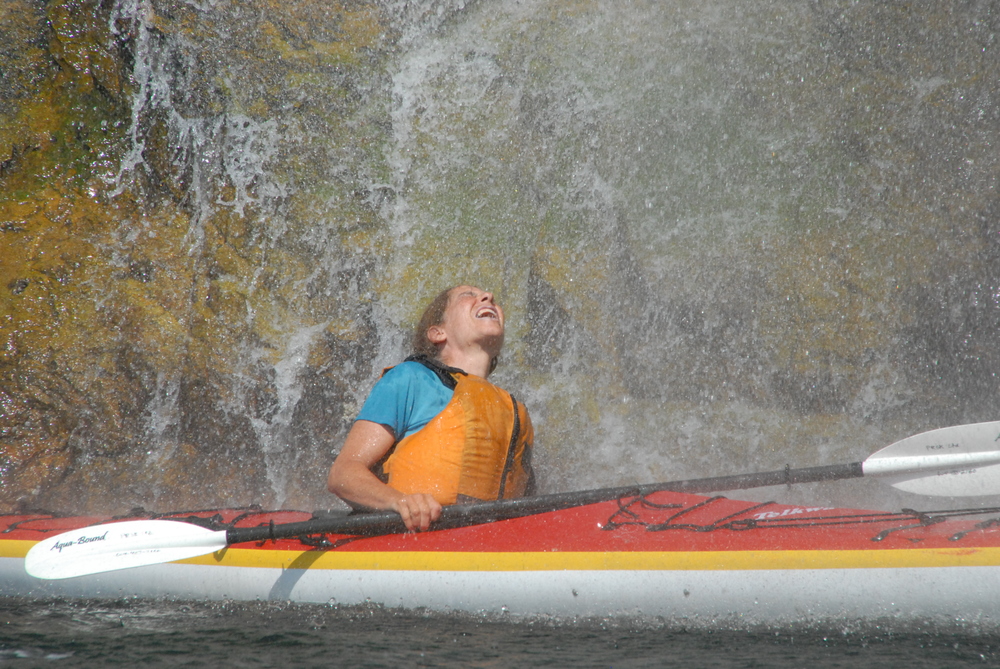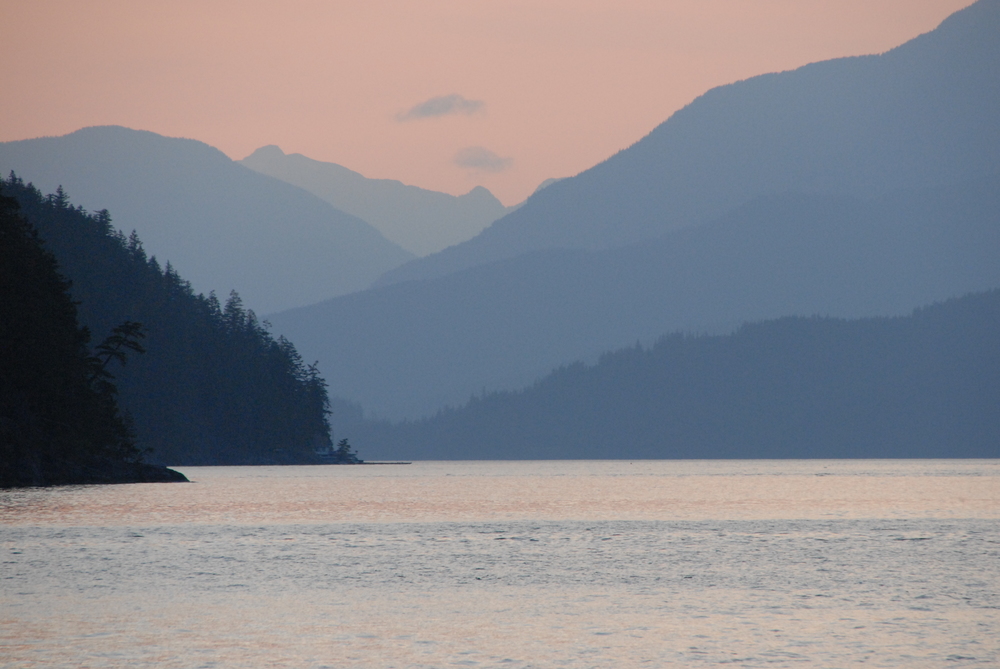words + photos by Don Mankin
My two Teva-clad feet poked above the water, framing the view of the mouth of the cove spilling into the broad channel before us. The silhouettes of several tree-covered islands and mountains overlapped in different shades of pastel and receded in the distance. I was floating on my back in the waters of coastal British Columbia. Not exactly the Caribbean – no palm trees, no rum drinks with paper umbrellas, and the water temperature was more than a tad or two colder. But the water was warm enough for a late afternoon swim, the scenery was more dramatic, and there was no one else to be seen other than my four sea kayaking companions relaxing after a long day of paddling in the warm bright sunshine of the aptly named Sunshine Coast.  photo by Tracy Mallory
photo by Tracy Mallory
The Sunshine Coast is just a relatively short drive and an even shorter flight northwest of Vancouver. It’s easily accessible but still feels somewhat remote -- most of the coast above Powell River, the “urban” center of the region, can only be reached by boat or float plane. Like almost all of the BC coast, it is strikingly beautiful -- islands of all sizes covered in Douglas fir, hemlock, and cedar; narrow inlets and fjords indenting the rugged coastline; and jagged snow capped mountains in the distance framing long views across wide sounds. But unlike most of the BC coast, the Sunshine Coast is in the rain shadow of the low mountains of Vancouver Island to the west, so the weather is usually sunny, dry and warm, sometimes very warm.
I was here because it was easily accessible and, therefore, relatively inexpensive, not an unimportant concern in this era of bursting economic bubbles and fiscal uncertainty. The trip that lured me here was the seven day “Into the Majestic Mountains” kayaking trip offered by Powell River Sea Kayak Ltd. (www.bcseakayak.com).
The four of us, not including our guide, rotated among two single kayaks and one double throughout the trip. This was a real plus for me. I have taken many sea kayak trips over the years, but have rarely had the chance to paddle the more maneuverable single for any length of time. Most trip operators prefer the more stable doubles, not an unimportant consideration when the waters are rough and cold. Truth be told, I was more than a little nervous about this, but I did just fine. What better place to confront one’s fears of tipping over than in the relatively warm, protected waters of the Sunshine Coast?
The Sunshine Coast is not a wilderness -- humans have worked and lived here for centuries -- but it is wild. In our six day paddle we saw bald eagles, loons, ducks, seals, orange and purple sea stars, and the occasional porpoise. We did not see any black bears or cougars, but they are there (from what I hear, you don’t actually see the cougars until it’s too late). There are even grizzlies in the remote inlets near the northern end of the Coast.
Most of the first two days was spent putting some distance between us and the boat traffic in and around Desolation Sound, one of the most popular boating destinations in the world. After that, the scenery grew more beautiful and dramatic, and we felt further removed from civilization. By the third day we were in a wild, scenic, and serene landscape with few signs of civilization other than the occasional boat, vacation house, or distant patch of logged and partially re-grown forest. We set up our tents on a high, rocky point jutting out into the water and went for a swim in the warm shallow waters of the cove below.
Our fourth day was sheer ecstasy. It was a layover day so we didn’t have to pack up camp and load the kayaks. After a leisurely breakfast we got in our kayaks to explore the nearby islands and channels. It was overcast at first, and the water was like glass. Everything was hushed. It was one of those magic paddles – a couple of hours of muted light and sound as we glided past rocky banks on the lookout for seals poking their heads above the water and eagles diving for fish. It was my turn in the single so I took every opportunity I could to go off on my own – but not too far off – to explore the rocky shores or spend a few minutes in thoughtful silence.

The next day we paddled to our last destination, Toba Inlet, a long fjord that cuts deep into the coastal mountains. After dinner -- featuring the oysters, mussels and clams we had gathered the day before -- we sat on the beach and gazed silently at the mountains growing dark across the inlet.
The plan for our last full day was to paddle deep into the inlet, then return to our campsite for our final night. Just a quarter mile or so from camp a tall waterfall cascaded down the steep slopes of the inlet into the water. We took turns paddling our kayaks under the waterfall for our only shower of the trip. It was cold but the air was warm so it really didn’t matter. After a couple of miles of paddling, we rafted all four kayaks together and hooked up a spare rain fly to the two outside kayaks and two paddles propped upright on the decks to create an improvised sail. The wind then took us on a wild ride down the narrow fjord.  photo by Tracy Mallory
photo by Tracy Mallory
After lunch on the beach at the end of the inlet, we paid for that ride. The wind at our backs on the way in was in our face on the way out. We battled the wind most of the way, but the thrill of sailing in the other direction was well worth it.
The next day, we packed up camp and paddled several miles to our pick-up point. After an exciting, 45 minute, high speed ride in a Zodiac, I headed to the airport for the short flight to Vancouver to meet my wife for a long weekend in what is one of the most beautiful and cosmopolitan cities in North America, perhaps the world. I felt relaxed and fit and was as tan as a European tourist in Miami Beach. Within a few minutes of landing we were off to one of the city’s many outstanding Chinese restaurants in a successful attempt to regain some of the weight I had lost during the trip.
It may not have been an exotic trip in a far corner of the world, but where else can you sail in a kayak down a wild fjord one day and eat some of the best Chinese food in the world the next, and not pay a small fortune to get there? There is a lot to be said for accessibility other than it’s easy to get to.
Don Mankin is a travel writer, business author, psychologist, organizational consultant and executive coach. The Wall Street Journal called his latest book, Riding the Hulahula to the Arctic Ocean: A Guide to 50 Extraordinary Adventures for the Seasoned Traveler (National Geographic, 2008), “one of the best travel books to cross our desk this year." For more information on Don or Riding the Hulahula, check out his website www.adventuretransformations.com.
 ✓ Subscribe to YourLifeisaTrip.com and be notified when new articles appear, click here. It's free, it's fun, and it keeps you on the cutting edge of what our writers are thinking.
✓ Subscribe to YourLifeisaTrip.com and be notified when new articles appear, click here. It's free, it's fun, and it keeps you on the cutting edge of what our writers are thinking.
If you enjoy the articles on YourLifeIsATrip.com, please visit another great resource and one of our sponsors, Prague-Stay.com, Prague's leading accommodation and lifestyle portal featuring premium serviced apartments, Prague boutique and design hotels, plus Prague lifestyle information.
